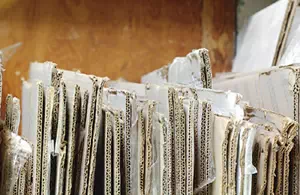 Paper Recycling
Paper Recycling
U.S. Healthcare facilities generate nearly two billion pounds of paper and cardboard waste every year. This is the largest category of waste in the annual total of five billion pounds of waste of all types from the healthcare sector. The dominance of paper in the waste stream is true of the economy as a whole. Paper and cardboard also constitute the largest single contributor to the overall municipal solid waste (MSW) stream. The good news is that paper also offers the greatest opportunity for recycling. At one time, the use of recycled fiber was relatively rare. Today, consumers buy recycled paper in newspapers, food packaging, tissue, and office paper, with some items containing up to 100 percent recycled fiber. Recovered paper is also used in materials such as insulation, gypsum wallboard, fertilizer bags, and mulch.As markets for recycled paper have expanded, it has become increasingly convenient for generators of paper waste to save money and reduce the quantity sent to landfills for disposal. As major generators of paper waste, healthcare facilities have a special responsibility to seek out recycling opportunities.Paper waste retains the most valuable if it is sorted by type. Facilities will find it worthwhile to educate their staff in recognizing the various types of paper waste, and in making it easy for everyone in the facility to segregate paper waste by providing separate, clearly marked containers wherever paper waste is likely to be generated. This page provides basic information on paper waste types and recycling opportunities, along with links to more detailed information.
Types of Paper
For recycling purposes, paper can be classified according to the quality of the paper fiber, and the quantity and type of ink and other contaminants included with the paper material. Fiber: Most paper is derived from wood, a complex material with two major constituents:
- cellulose, the most desirable component for high quality paper. Like starch, cellulose is a long chain of sugar molecules. But while starch is easily converted back into sugar, and is thus used by both animals and plants for storing food, cellulose is much more resistant to degradation, and is used by plants to form tough structural units like stems and root fibers.
- lignin, a shorter but in some ways a more complex molecule, that cross-links the cellulose fibers, giving wood its characteristic rigidity
- Office Paper
- Magazines
- Newspapers, Telephone Directories
- Corrugated Boxes
Impacts of papermaking
- At about 36 percent, paper and paperboard products constitute the largest portion of the MSW stream.
- Americans generated nearly 82 million tons of paper products in the MSW stream in 2001, nearly a three-fold increase from 1960.
- Several toxic chemicals, including toxic sulfur compounds and chlorine, are used and discarded in making paper from wood
Compliance Requirements
The major compliance issue associated with paper waste involves the Health Insurance Portability and Accountability Act (HIPAA). Among many other provisions, HIPAA requires that healthcare facilities protect patient confidentiality. This applies in particular to the massive quantities of paper records that healthcare facilities typically generate. HIPAA requirements both encourage and complicate paper recycling. On the one hand, it forces facilities to do something more elaborate than bundling up the paper and getting it carted off to a landfill -- the records must be rendered illegible. Pulping, or shredding first and then pulping, will serve the purpose. This should ensure that the fiber will enter the recycling stream (although it never hurts to get clear information from your service provider on the fate of the material). On the other hand, HIPAA precludes simply passing patient records off to a garden-variety recycler, since the facility must ensure against unauthorized access to the records. That may mean locked containers, and definitely does mean dealing with recyclers that can certify that they themselves are HIPAA compliant.
Alternatives
- Reduction in use when possible
- Source reduction is the process of reducing the amount or toxicity of waste generated. One form of source reduction is "lightweighting." Lightweighting means reducing the weight and/or volume of a package or container, which saves energy and raw materials
- As early as 1983, companies manufacturing food service disposables began reducing the weight of plates, bowls, containers, trays and other tableware. Manufacturers of paper food service disposables have been able to source reduce by decreasing the paper stock required to manufacture food service containers and coating the containers with a very thin layer of polyethylene or wax. The coating enables the container to maintain its strength and food-protection functions.
- Maximize recycled content of papers you buy
Recycling
- Reduces greenhouse gas emissions that could lead to damaging climate change.
- Saves money since recycling fiber is cheaper than harvesting and processing virgin fiber.
- For hospitals: recycling helps reduce cost of waste disposal.
- Saves considerable landfill space, since paper products constitute the largest fraction of MSW—accounting for nearly 40 percent of all MSW generated, according to EPA.
- Reduces the volume of waste burned in waste combustors, thus reducing air emissions
More Resources
- National Office Paper Recycling Project's Office Paper Recycling Guide EPA. 1991.
- Greenhouse Gas Emissions From Management of Selected Materials in Municipal Solid Waste. (EPA530R-98-013). 1998



